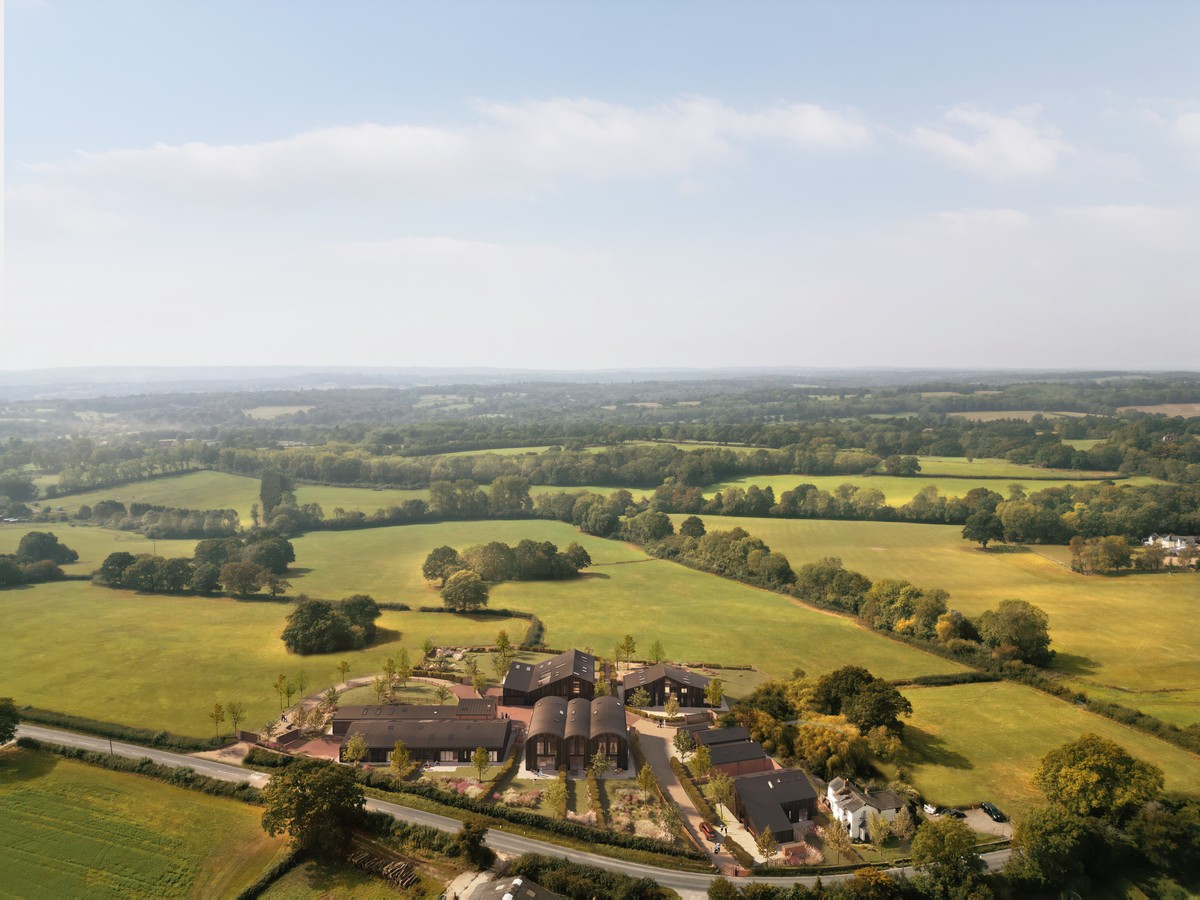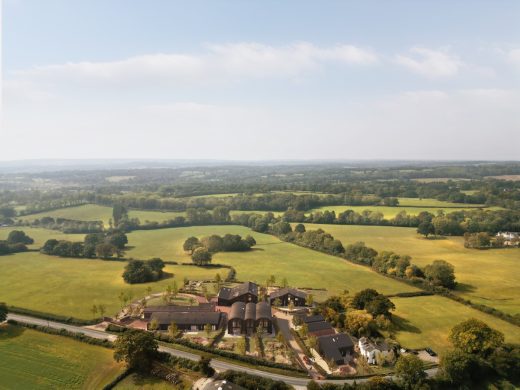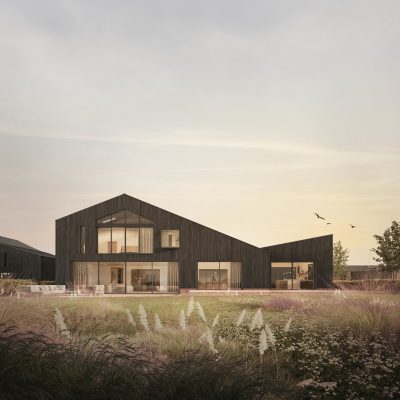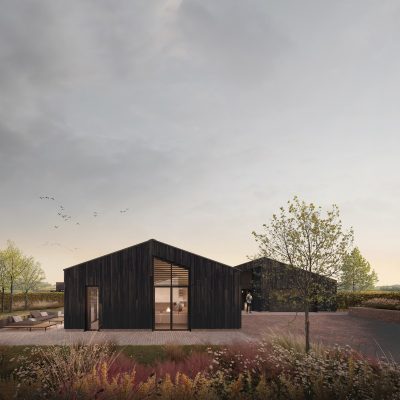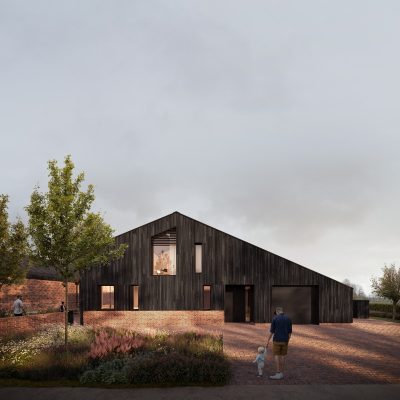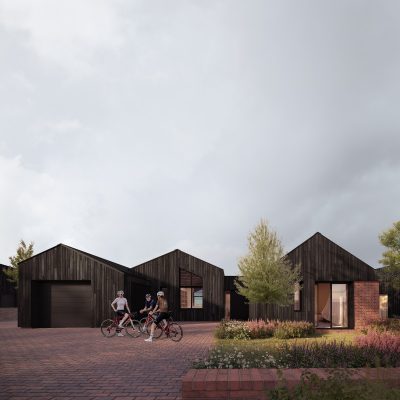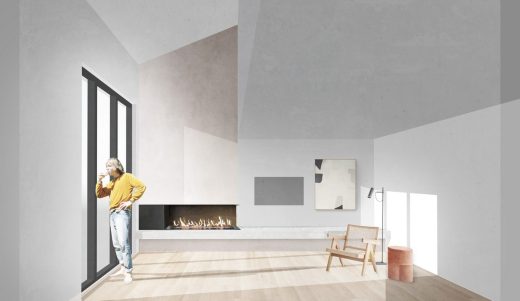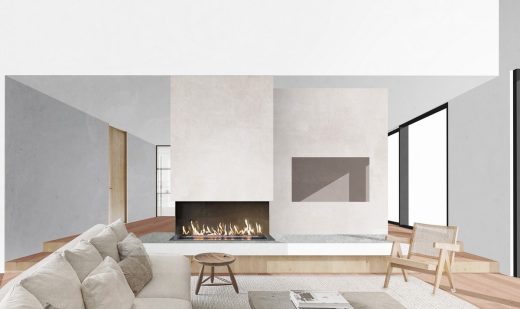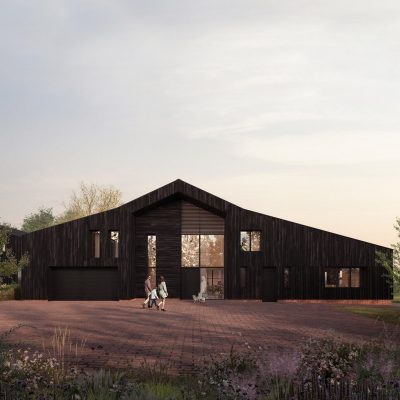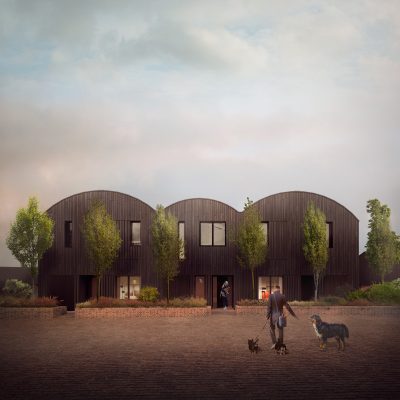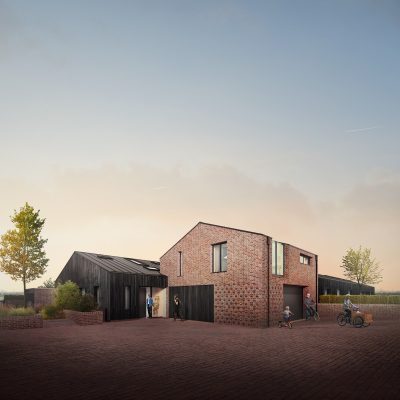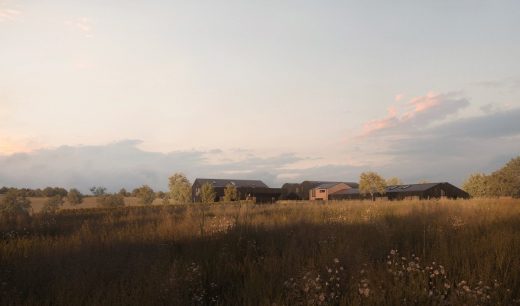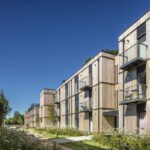Hartdene Barns, ANOB Kent property images, Modern Southeast England residences, UK homes design
Hartdene Barns, Kent, Southeast England
11 April 2024
Architect: Nissen Richards Studio
Location: on the border of West Kent and East Sussex, Southeast England, United Kingdom
Elevations / internal view renderings by Nissen Richards Studio ; other images by Hazeviz for Q New Homes
Hartdene Barns in Kent, UK
Nissen Richards Studio releases visuals for Hartdene Barns – a former dairy farm transformed into nine luxury eco dwellings, built to RIBA Climate Challenge standards
Nissen Richards Studio is working with developer Q New Homes on Hartdene Barns, a stunning collection of nine new homes, set within forty acres of land within an ANOB (Area of Outstanding Natural Beauty) in the UK’s green belt, close to the villages of Hartfield and Cowden on the border of West Kent and East Sussex.
The design-led development is comprised of nine carbon net zero, highly-sustainable eco homes, which have been designed to meet the RIBA’s Climate Challenge criteria. The houses will be clad in a striking charred larch treatment and come complete with a range of energy-efficient features, such as air source heat pumps, solar photovoltaic panels, extensive insulation, MVHR systems and electric car charging points. The whole-life carbon assessor regulating the project has declared the properties to be 10-15 years ahead of the majority of new-builds, per floor area, expected in the UK, stating that once completed, the Hartdene Barns development ‘will easily be among some of the most environmentally friendly houses in the entire UK.’
About Q New Homes
Q New Homes is an ambitious private residential property development company operating in South East London and across the home counties of Kent, Surrey and Sussex. The company is owned and led by brothers Damien and Michael Wynne, the driving force behind the Hartdene Barns project. Their unwavering commitment to the creation of high-quality housing breathes new life into underutilised sites, providing much-needed homes and transforming complex and challenging sites into captivating opportunities. Damien and Michael also act as both developer and main contractors on all projects to ensure complete quality control from concept to completion.
Damien Wynne, Director, Q New Homes, commented on Hartdene Barns: ‘The dwellings all have their own special architectural moments that set them apart from the norm and demonstrate our attention to detail and our willingness to embrace design excellence, with support from our long-standing relationship with Nissen Richards Studio.’
The Site
The site is a former dairy farm which had been in the same family for several generations until the death of the last farmer in 2017. Over the last years of the 93-year-old’s tenure, the farm had fallen into a state of disrepair, ending up as a series of rather dilapidated agricultural buildings and lean-tos. Whilst some former farm buildings have been demolished as part of the new vision, enabling the opening up of a central courtyard, as well as creating views out towards the landscape beyond, much will also be retained, with the shape of the new-build dwellings dictated to a large extent by the existing agricultural structures.
The development will be made up of six new structures in total, with two of the homes semi-detached and three in a terrace formation under a series of distinctive curved roof forms. The properties range from 2 to 6-bedrooms, with the largest measuring 6,500 square feet. Each has a private garden area and one also has a pond in its grounds.
The Vision
When Q New Homes purchased the site, planning permission was already in place for a scheme created by a firm of local architects which sought to retain 10 buildings (nine former agricultural buildings and the farmhouse), whilst demolishing some of the smaller, peripheral structures. The key stipulation was that the new dwellings should retain the shapes of the existing farm buildings, so that the houses would essentially be conversions and retain an echo of their previous lives and a sense of place. Q New Homes then appointed architects Nissen Richards Studio, with whom they had already worked over the past decade on several residential developments, to develop the vision further. Nissen Richards Studio kept to the proposed building footprints but changed the buildings’ form and created new interior layouts and radically-altered exteriors, featuring darkened, charred timber and dark multi bricks rather than the pale timber originally proposed.
‘We developed, amended and resubmitted the plan’, Jim Richards, Director of Nissen Richards Studio explained, ‘retaining original structures and respecting the footprint of the original planning document, whilst conceptualising a new materials strategy.’
Planning Consent for the development involved 25 conditions—12 of which were pre-commencement, relating to ground investigations, archaeology, environment and ecology, as well as more standard conditions. Currently, the scheme is at its halfway point, with all homes expected to reach practical completion at the end of 2024. Nonetheless, the residential project has already been praised for its sustainability credentials. According to the development’s whole-life carbon assessor, the scheme already exceeds the target goals set by the Carbonlite Challenge and the RIBA’s Climate Challenge.
Materials Palette
A rich palette of high-quality materials will be utilised to create the development, seeking to reflect the agricultural aesthetic of the original barns but with an added contemporary twist.
‘The process of charring timber makes it an extremely stable material that won’t shrink or move’ Andrea Hickey, Associate and Senior Architect at Nissen Richards Studio commented. ‘It also has a very long lifetime and doesn’t need upkeep. It’s an expensive process to go through, but very effective in the long run, making it a really high-performance external cladding material.’
The external look of the homes will be made up of black standing seam zinc roofing; medium fired, charred timber (larch) boards; deep char, charred timber (larch) board; black aluminium powder coated window and door frames; Michelmersh Selected Dark brickwork and clear glazing. A variety of cladding patterns have been developed and will be utilised across the site to highlight entrances and feature areas. These both add tactility and break up the sometimes vast elevations. The family of patterns also helps create a unique design for each dwelling, whilst also unifying the scheme as a whole. It includes ship-lapped vertical boarding with varying widths of boards and rectangular boards with alternating vertical fins with open joints. There is large glazing where there are large views. Some glazing is more playful with smaller windows where the view is over common areas.
In contrast to the dark exteriors, the property interiors will be light, bright and filled with natural tones. The neutrality of the interior design will create a luxurious backdrop for prospective owners to inhabit and personalise. The design principle inside is to express the forms through, for example, vaulted high ceilings. Full-height, glazed crittal style doors will be used internally to create a connection between the primary living spaces and entrance hall. Stairs, some light and some solid, reflect the various internal layouts of the properties. The staircases will feature a crafted handrail with metal balusters and either a slatted or solid timber balustrade. There will be a slatted wall next to the ‘floating’ stairs along with a wall-mounted timber handrail.
The palette for the kitchen utilises a combination of rich materials, such as quartz worktops, alongside timber. The kitchens aim to create a neutral backdrop to the adjacent living spaces, which also pick up on the muted greens of the external landscape. Feature fireplaces have been utilised across the houses to help divide and spatially organise the large open plan kitchen, living, dining spaces. They create a warm focal point within each space from which furniture can be organised and laid out.
The master bedrooms feature light and neutral colours expressed through timber bespoke joinery and natural fabrics. Beds are orientated towards large windows to maximise views out to the surrounding landscape. There’s a neutral palette to the bathrooms with contrasting dark tapware. Large format tiling and textured small tiles create feature walls and distinguish different areas within the room.
Project Funding
The project has been financed by a specialist low-carbon loan, a financial instrument designed to connect property developers working on sustainable projects with investors looking to put money into green schemes. The funders in this case are Atelier, who have signed up for the RIBA Climate Change Challenge 2025 and 2030. As a condition of the money being granted, Q New Homes had to undertake a whole-life carbon assessment of the project.
Low-carbon Construction
The development is adopting a high standard of environmental design, utilising special fabrics, plant enhancements and green technology to maximise energy savings. The buildings are being constructed using structural insulated panels (SIPs) with glulam beams rather than steel, for example, together with low-carbon concrete.
‘Some of the old steel uprights from the existing buildings have been retained for reuse, and all the old concrete has been crushed for use as hardcore, helping ensure a build with very low embodied carbon’ Jim Richards explained.
Sustainability is also embedded in the fabric through the use of eco-friendly materials. The house structures are made of lightweight timber, as opposed to heavy, carbon-intensive masonry. Weight-bearing, glued, laminated timber columns and the gulam beams are also helping to save money and reduce the scheme’s carbon footprint, as they’re both cheaper and less energy intensive compared to steel at the point of manufacturing. The ceiling beams feature metal web joists, which have been manufactured off-site and use less timber to achieve the joist strength and loading capability required, providing easy access for mechanical and electrical services thereby, whilst also making them more labour- and cost-effective.
The structurally-insulated panels by SIPS ECO consist of a foam core sandwiched between two rigid facings, which reduce embodied carbon by 40% compared to traditional masonry construction. SIPs also create an unbroken, thermally-efficient envelope around each dwelling, enhancing the performance of green technologies and minimising cold bridging. Each home is also cocooned in insulation, fortified by an internal wrap vapour control layer and an air seal that ensures airtightness.
Thanks to all the sustainability features implemented, future homeowners will only pay for water and electricity, and will not require gas. During the coldest months of the year, when the demand for electricity and heating will be the highest, the average bill is estimated to be around £40 per month. The homes will also feature fireplaces that burn bioethanol—a renewable energy source derived from food.
Local Habitats
The landscaping and planting across the site aim to support and enhance local habitats. Careful consideration has been given to the chosen plants with native species selected to support and benefit local wildlife. The 6500-acre Ashdown Forest is also close by, offering unrivalled open space in the South East of England. The Forest is at the heart of the High Weald Area of Outstanding Natural Beauty and has national and international protection because of its wildlife.
Hartdene Barns in Kent, Southeast England – Building Information
Client/Main Contractor: Q New Homes
Architect: Nissen Richards Studio – https://www.nissenrichardsstudio.com/
Structure: Jonathan Darnell Engineering
Civils: Bellamy Wallce Partnership (BWP)
SIP Structure: Paramount Structures
SIP Manufacturer: SIPs Eco
M&E: Integration
Whole Life Carbon: Darren Evans
Visuals:
All elevations / internal views by Nissen Richards Studio
All other visuals created by Hazeviz for Q New Homes
About Nissen Richards Studio:
Nissen Richards Studio is a double RIBA National Award-winning architects’ practice and exhibition design studio, working with many of the world’s greatest cultural institutions, from The Courtauld Gallery, British Museum, British Library, National History Museum, National Trust, The Wallace Collection, Wordsworth Trust, Kensington Palace and The Imperial War Museum in the UK to Kode, MUNCH and the National Library of Norway internationally. Most recently, the Studio completed the permanent exhibition design and interpretation for 37 galleries within The National Portrait Gallery.
Founded in 2010 and led by Directors Pippa Nissen and Jim Richards, Nissen Richards Studio’s approach combines a respect for all the voices in a project, a willingness to experiment, a unique storyboarding process and a fusion of architectural and theatre design processes. Nissen Richards Studio’s clear systems of thinking, working and communicating, together with a boundless curiosity about the world, translate into beautifully-designed spaces for people to come to, be stimulated by, enjoy and remember. In 2022, the Studio’s work, including a new-build viewing tower, at Anglo-Saxon royal burial site Sutton Hoo won an RIBA National Award, whilst in 2023, Nissen Richards Studio was part of the team that won an RIBA National Award for the transformation of The Courtauld Gallery, with the scheme going on to be shortlisted for The Stirling Prize and winning the RIBA People’s Poll Award.
Renders: elevations / internal views by Nissen Richards Studio – other images: Hazeviz for Q New Homes
Hartdene Barns, Kent, Southeast England images / information received 110424
Location: Canterbury, Kent, south east England, United Kingdom
Kent Buildings
Contemporary Kent Properties
Lake Cabin in Brabourne, Kent Downs Area of Outstanding Beauty, South East England
Design: RX Architects
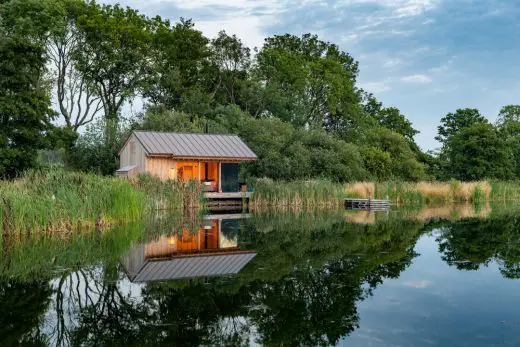
photo : Ashley Gendek
Lake Cabin in Kent Downs
Black House
Architect: AR Design Studio
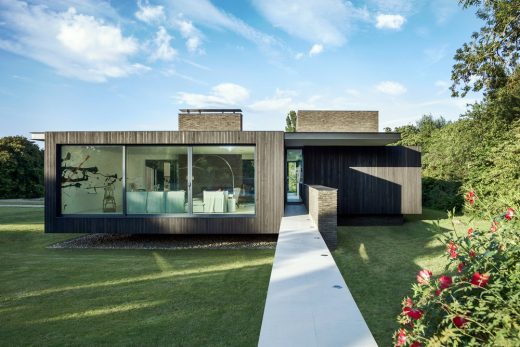
image courtesy of architects
Black House in Kent
Woven, Broadstairs
Architects: Giles Miller Studio
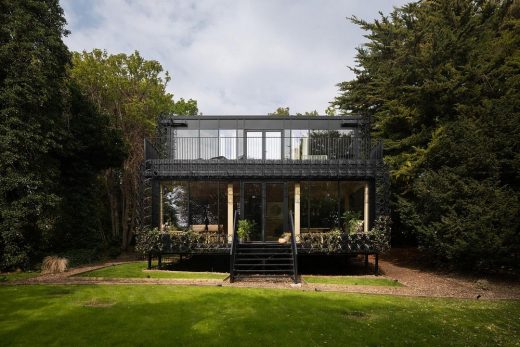
photos : Rachel Ferriman and Edvinas Bruzas
Woven House, Broadstairs
Caring Wood, Leeds, Maidstone
Design: Macdonald Wright Architects
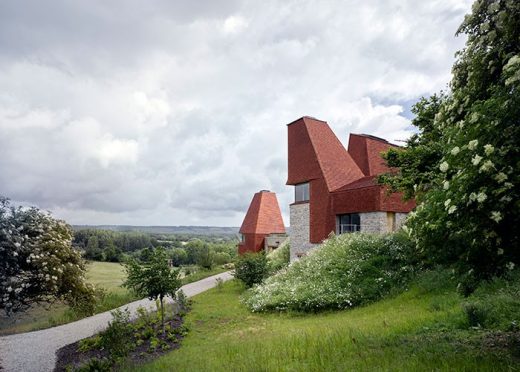
photo © James Morris
Caring Wood Residence in Kent
Canterbury Buildings
Contemporary Canterbury Architecture Designs
Kent & Medway Medical School
Architects: Hazle McCormack Young LLP
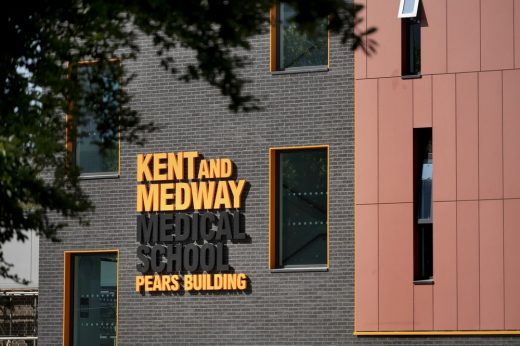
image courtesy of architects
Kent & Medway Medical School
Templeman Library
Architects: Penoyre & Prasad
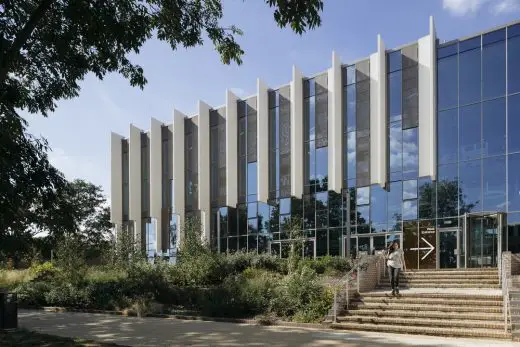
photo © Tim Crocker
Templeman Library in Canterbury
Contemporary Kent Architecture
Curious Brewery
Architect: Guy Hollaway Architects
Curious Brewery Ashford Building
Fort Burgoyne in Dover
Design: Lee Evans Partnership, Architects
Fort Burgoyne in Dover
English Houses Designs
English Residential Property – recent architectural selection below:
Sea Breeze, Camber Sands beach, Sussex
Design: RX Architects
photo : Richard Chivers
Sea Breeze on Camber Sands beach, East Sussex
Island Rest, Isle of Wight
Design: Strom Architects
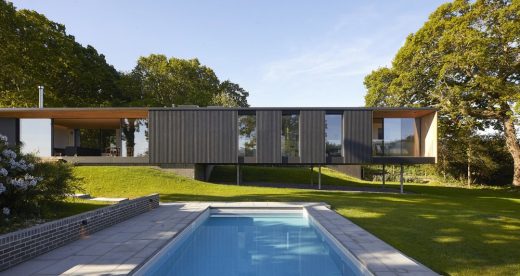
photos by Nick Hufton, Al Crow
Island Rest Isle of Wight Residence
Design: Strom Architects
image : LB Visualisation
Ghyll House, East Sussex Property
Architects: Ström Architects
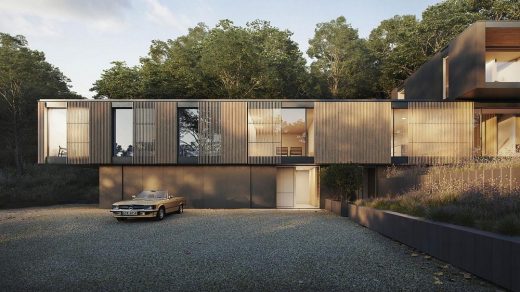
image : Numa
Applehurst House
Comments / photos for Hartdene Barns, Kent, Southeast England – Contemporary properties design by Nissen Richards Studio page welcome.

